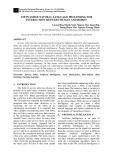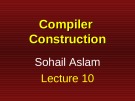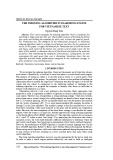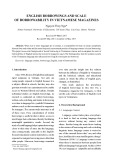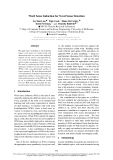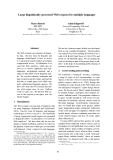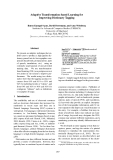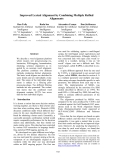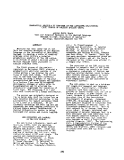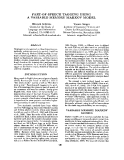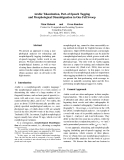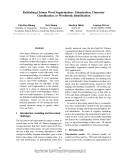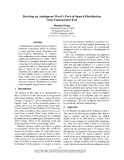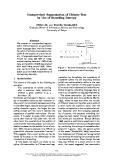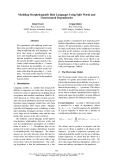
Word tokenization
-
In this paper, with these algorithms, artificial intelligent supported is much complex, people can communicate naturally with robot, not only English but also Vietnamese as well. In this paper, we will introduce the specification and intelligent interaction processing in naturally Vietnamese.
 8p
8p  vidoctorstrange
vidoctorstrange
 06-05-2023
06-05-2023
 11
11
 4
4
 Download
Download
-
Information retrieval techniques: Lecture 8. The main topics covered in this chapter include: parsing a document; complications: format/language; precision and recall; tokenization; numbers; tokenization: language issues; stop words;... Please refer to the content of document.
 16p
16p  tieuvulinhhoa
tieuvulinhhoa
 22-09-2022
22-09-2022
 6
6
 3
3
 Download
Download
-
Lecture Compiler construction: Lesson 10 - Sohail Aslam. The main topics covered in this chapter include: using generated scanner, input tokenized, flex input for C++, ISO C++ lexical analyzer, Front-End parser, checks the stream of words and their parts of speech for grammatical correctness,...
 33p
33p  youzhangjing_1909
youzhangjing_1909
 28-04-2022
28-04-2022
 11
11
 1
1
 Download
Download
-
In this paper, we apply the tokenizer for Vietnamese text to build the lexicon and hence, each record of the lexicon may contain several single words. On the basis of this method, we decrease the size of the lexicon and improve the precision of search while maintaining the complexity of the process.
 8p
8p  viengland2711
viengland2711
 23-07-2019
23-07-2019
 8
8
 0
0
 Download
Download
-
This paper reviews the background of lexical borrowing in Vietnamese context and investigates the scale of borrowability of English tokens that occured in magazine issues. The findings show that the syntactic system of the Vietnamese language has influenced how English word types are borrowed.
 9p
9p  miulovesmile4
miulovesmile4
 19-11-2018
19-11-2018
 26
26
 1
1
 Download
Download
-
In the last three iterations 23 subjects performed in all 107 dialogues with 28 different scenarios using a total of 4455 words. The constraints (1) and (2) above on vocabulary size and maximum and average user utterance length have been met. In the last iteration only 3 user utterances out. of 881 contained more than 10 tokens and the average number of tokens per user turn was 1.85.
 1p
1p  buncha_1
buncha_1
 08-05-2013
08-05-2013
 31
31
 2
2
 Download
Download
-
Work at the Unit for Computer Research on the Eaglish Language at the University of Lancaster has been directed towards producing a grammatically snnotated version of the Lancaster-Oslo/ Bergen (LOB) Corpus of written British English texts as the prel~minary stage in developing computer programs and data files for providing a grammatical analysis of -n~estricted English text. From 1981-83, a suite of PASCAL programs was devised to automatically produce a single level of grammatical description with one word tag representing the word class or part of speech of each word token in the corpus.
 7p
7p  buncha_1
buncha_1
 08-05-2013
08-05-2013
 43
43
 1
1
 Download
Download
-
We apply topic modelling to automatically induce word senses of a target word, and demonstrate that our word sense induction method can be used to automatically detect words with emergent novel senses, as well as token occurrences of those senses. We start by exploring the utility of standard topic models for word sense induction (WSI), with a pre-determined number of topics (=senses). We next demonstrate that a non-parametric formulation that learns an appropriate number of senses per word actually performs better at the WSI task. ...
 11p
11p  bunthai_1
bunthai_1
 06-05-2013
06-05-2013
 46
46
 4
4
 Download
Download
-
Báo cáo khoa học: "TBL-Improved Non-Deterministic Segmentation and POS Tagging for a Chinese Parser"
Although a lot of progress has been made recently in word segmentation and POS tagging for Chinese, the output of current state-of-the-art systems is too inaccurate to allow for syntactic analysis based on it. We present an experiment in improving the output of an off-the-shelf module that performs segmentation and tagging, the tokenizer-tagger from Beijing University (PKU). Our approach is based on transformation-based learning (TBL).
 9p
9p  bunthai_1
bunthai_1
 06-05-2013
06-05-2013
 35
35
 2
2
 Download
Download
-
The Web contains vast amounts of linguistic data. One key issue for linguists and language technologists is how to access it. Commercial search engines give highly compromised access. An alternative is to crawl the Web ourselves, which also allows us to remove duplicates and nearduplicates, navigational material, and a range of other kinds of non-linguistic matter. We can also tokenize, lemmatise and part-of-speech tag the corpus, and load the data into a corpus query tool which supports sophisticated linguistic queries.
 4p
4p  bunthai_1
bunthai_1
 06-05-2013
06-05-2013
 51
51
 2
2
 Download
Download
-
We present an adaptive technique that enables users to produce a high quality dictionary parsed into its lexicographic components (headwords, pronunciations, parts of speech, translations, etc.) using an extremely small amount of user provided training data. We use transformationbased learning (TBL) as a postprocessor at two points in our system to improve performance.
 8p
8p  bunthai_1
bunthai_1
 06-05-2013
06-05-2013
 49
49
 2
2
 Download
Download
-
We describe a word alignment platform which ensures text pre-processing (tokenization, POS-tagging, lemmatization, chunking, sentence alignment) as required by an accurate word alignment. The platform combines two different methods, producing distinct alignments. The basic word aligners are described in some details and are individually evaluated. The union of the individual alignments is subject to a filtering postprocessing phase. Two different filtering methods are also presented. The evaluation shows that the combined word alignment contains 10.
 8p
8p  bunthai_1
bunthai_1
 06-05-2013
06-05-2013
 50
50
 2
2
 Download
Download
-
Research has been under way at the Unit for Computer Research on the ~hglish Language at the University of Lancaster, England, to develop a suite of computer programs which provide a detailed grammatical analysis of the LOB corpus, a collection of about 1 million words of British English texts available in machine readable form. The first phrase of the pruject, completed in September 1983, produced a grammatically annotated version of the corpus giving a tag showing the word class of each word token. ...
 6p
6p  bungio_1
bungio_1
 03-05-2013
03-05-2013
 31
31
 1
1
 Download
Download
-
We present a new approach to disambiguating syntactically ambiguous words in context, based on Variable Memory Markov (VMM) models. In contrast to fixed-length Markov models, which predict based on fixed-length histories, variable memory Markov models dynamically adapt their history length based on the training data, and hence may use fewer parameters. In a test of a VMM based tagger on the Brown corpus, 95.81% of tokens are correctly classified.
 7p
7p  bunmoc_1
bunmoc_1
 20-04-2013
20-04-2013
 50
50
 3
3
 Download
Download
-
For languages whose character set is very large and whose orthography does not require spacing between words, such as Japanese, tokenizing and part-of-speech tagging are often the difficult parts of any morphological analysis. For practical systems to tackle this problem, uncontrolled heuristics are primarily used. The use of information on character sorts, however, mitigates this difficulty. This paper presents our method of incorporating character clustering based on mutual information into DecisionTree Dictionary-less morphological analysis.
 5p
5p  bunrieu_1
bunrieu_1
 18-04-2013
18-04-2013
 57
57
 2
2
 Download
Download
-
We present an approach to using a morphological analyzer for tokenizing and morphologically tagging (including partof-speech tagging) Arabic words in one process. We learn classifiers for individual morphological features, as well as ways of using these classifiers to choose among entries from the output of the analyzer. We obtain accuracy rates on all tasks in the high nineties.
 8p
8p  bunbo_1
bunbo_1
 17-04-2013
17-04-2013
 65
65
 2
2
 Download
Download
-
This paper addresses two remaining challenges in Chinese word segmentation. The challenge in HLT is to find a robust segmentation method that requires no prior lexical knowledge and no extensive training to adapt to new types of data. The challenge in modelling human cognition and acquisition it to segment words efficiently without using knowledge of wordhood. We propose a radical method of word segmentation to meet both challenges.
 4p
4p  hongvang_1
hongvang_1
 16-04-2013
16-04-2013
 46
46
 2
2
 Download
Download
-
A distributional method for part-of-speech induction is presented which, in contrast to most previous work, determines the part-of-speech distribution of syntactically ambiguous words without explicitly tagging the underlying text corpus. This is achieved by assuming that the word pair consisting of the left and right neighbor of a particular token is characteristic of the part of speech at this position, and by clustering the neighbor pairs on the basis of their middle words as observed in a large corpus.
 4p
4p  hongvang_1
hongvang_1
 16-04-2013
16-04-2013
 39
39
 1
1
 Download
Download
-
Figure 1: Intuitive illustration of a variety of successive tokens and a word boundary mentation by formalizing the uncertainty of successive tokens via the branching entropy (which we mathematically de ne in the next section). Our intention in this paper is above all to study the fundamental and scienti c statistical property underlying language data, so that it can be applied to language engineering. The above assumption (A) dates back to the fundamental work done by Harris (Harris, 1955), where he says that when the number of di erent tokens coming after every pre x of a word marks...
 8p
8p  hongvang_1
hongvang_1
 16-04-2013
16-04-2013
 40
40
 1
1
 Download
Download
-
We experiment with splitting words into their stem and suffix components for modeling morphologically rich languages. We show that using a morphological analyzer and disambiguator results in a significant perplexity reduction in Turkish. We present flexible n-gram models, FlexGrams, which assume that the n−1 tokens that determine the probability of a given token can be chosen anywhere in the sentence rather than the preceding n − 1 positions. Our final model achieves 27% perplexity reduction compared to the standard n-gram model. ...
 4p
4p  hongphan_1
hongphan_1
 15-04-2013
15-04-2013
 49
49
 1
1
 Download
Download







